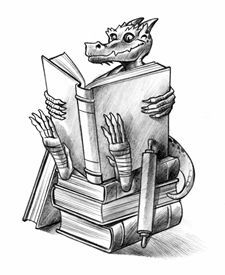 What qualifies as “dropping” an opponent when you’re using Cleave feat? For instance, if I use the Knock-down feat and successfully trip my opponent, does that count? [More…]
What qualifies as “dropping” an opponent when you’re using Cleave feat? For instance, if I use the Knock-down feat and successfully trip my opponent, does that count? [More…]
The intended requirement is reducing the opponent to 0 hit points or less. (That is, make him “drop”). That also would include knocking out a foe with a nonlethal attack.
Just tripping someone doesn’t count when I’m running the game. That would include regular trip attacks or the Improved Trip feat. Knock-down seems like a special case to me. This feat literally allows you to whack a foe hard enough to knock him off his feet. While I would not allow you a free attack when have the Improved Trip feat and you use Knock-down to beat someone to the ground, I would allow a successful Knock-down to trigger a Cleave. After all, you’re smacking a foe hard enough to send the creature crashing to the ground.
There are a few places where it isn’t clear whether you’ve truly dropped a foe. For example, the mirror image spell creates multiple images of the caster, which confuse an attacker. A single hit dispels an image. So, is that dropping a foe? I don’t think so. A mirror image spell uses a mass of illusory images as a way to make attacks miss, and an image isn’t a separate foe. On the other hand, if you want to allow a character to Cleave through a mass of images, it probably won’t sink your game.
Combat Powers and Feats
Creatures have powers that allow them to fight in unusual ways for much the same reason that the game offers characters feats that give them new combat powers. Both introduce new challenges and expanded opportunities during a battle.
A combat against a medusa or other creature with a gaze attack feels different, even a little alien, because the players must deal with the gaze attack with methods they don’t need to use in most battles, and dealing with petrified allies after the dust settles is no picnic either.
When questions arise over a combat power, keep the foregoing in mind, and take care to preserve the unusual properties the power brings to the game. In the case of a gaze attack, the unusual property is its automatic nature. It’s dangerous just to be near a foe with a gaze attack.
Adjudicate combat feats in much the same way, except that you also must take care to avoid creating overpowered combinations. The Cleave feat discussed here is fairly easy to handle, because it doesn’t work very often. Allowing Cleave attacks after Knock-downs makes Cleave much more useful and powerful, but it also allows a character to use cleave against foes that have two many hit points to drop quickly during a battle. That keeps the Cleave feat in play a little longer and it gives characters who’ve chosen the Cleave feat something else to consider besides just the Great Cleave feat.
Got a question for the Kobold? Ask in comments or on the Forum!

Question!
Currently my group is playing a Gestalt Campaign. Our characters and a reasonable amount of foes are gestalts, but I am left with one grave conundrum: Psychic Warrior/Monk
PsyWarriors have a big array of spells that either improve their weapon, or create a natural weapon(claw), and spells that improve those items(like truevenom/truevenom weapon).
The goal with my monk was to keep the PsyWarrior powers as restricted to “Monk goes Mad” as possible.
In such a case, can I use Metaphysical claw on my unarmed strike? Or would it be Metaphysical Weapon? Both? Neither?
If I *have* to use either a claw or a weapon for these powers, will I retain my special abilities like flurry and stunning fist with a claw attack?
Ebberon had a few feats that allowed monks to use certain weapons as monk weapons. This way you could use metaphysical longswords and still be 100% legit.
The monk class description says you can treat the monk’s unarmed strike as either a manufactured weapon or as a natural weapon.
Also,, I’ve recorded this answer for an upcoming podcast, so be sure to give a listen!